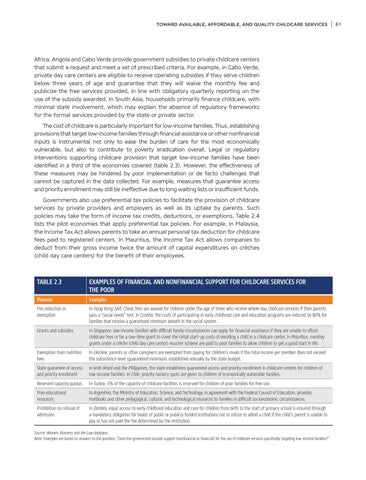TOWARD AVAILABLE, AFFORDABLE, AND QUALITY CHILDCARE SERVICES
Africa, Angola and Cabo Verde provide government subsidies to private childcare centers that submit a request and meet a set of prescribed criteria. For example, in Cabo Verde, private day care centers are eligible to receive operating subsidies if they serve children below three years of age and guarantee that they will waive the monthly fee and publicize the free services provided, in line with obligatory quarterly reporting on the use of the subsidy awarded. In South Asia, households primarily finance childcare, with minimal state involvement, which may explain the absence of regulatory frameworks for the formal services provided by the state or private sector. The cost of childcare is particularly important for low-income families. Thus, establishing provisions that target low-income families through financial assistance or other nonfinancial inputs is instrumental not only to ease the burden of care for the most economically vulnerable, but also to contribute to poverty eradication overall. Legal or regulatory interventions supporting childcare provision that target low-income families have been identified in a third of the economies covered (table 2.3). However, the effectiveness of these measures may be hindered by poor implementation or de facto challenges that cannot be captured in the data collected. For example, measures that guarantee access and priority enrollment may still be ineffective due to long waiting lists or insufficient funds. Governments also use preferential tax policies to facilitate the provision of childcare services by private providers and employers as well as its uptake by parents. Such policies may take the form of income tax credits, deductions, or exemptions. Table 2.4 lists the pilot economies that apply preferential tax policies. For example, in Malaysia, the Income Tax Act allows parents to take an annual personal tax deduction for childcare fees paid to registered centers. In Mauritius, the Income Tax Act allows companies to deduct from their gross income twice the amount of capital expenditures on crèches (child day care centers) for the benefit of their employees.
TABLE 2.3
EXAMPLES OF FINANCIAL AND NONFINANCIAL SUPPORT FOR CHILDCARE SERVICES FOR THE POOR
Measure
Examples
Fee reduction or exemption
In Hong Kong SAR, China, fees are waived for children under the age of three who receive whole-day childcare services if their parents pass a “social needs” test. In Croatia, the costs of participating in early childhood care and education programs are reduced by 80% for families that receive a guaranteed minimum benefit in the social system.
Grants and subsidies
In Singapore, low-income families with difficult family circumstances can apply for financial assistance if they are unable to afford childcare fees or for a one-time grant to cover the initial start-up costs of enrolling a child in a childcare center. In Mauritius, monthly grants under a crèche (child day care center) voucher scheme are paid to poor families to allow children to get a good start in life.
Exemption from nutrition fees
In Ukraine, parents or other caregivers are exempted from paying for children’s meals if the total income per member does not exceed the subsistence level (guaranteed minimum) established annually by the state budget.
State guarantee of access and priority enrollment
In both Brazil and the Philippines, the state establishes guaranteed access and priority enrollment in childcare centers for children of low-income families. In Chile, priority nursery spots are given to children of economically vulnerable families.
Reserved capacity quotas
In Turkey, 3% of the capacity of childcare facilities is reserved for children of poor families for free use.
Free educational resources
In Argentina, the Ministry of Education, Science, and Technology, in agreement with the Federal Council of Education, provides textbooks and other pedagogical, cultural, and technological resources to families in difficult socioeconomic circumstances.
Prohibition on refusal of admission
In Zambia, equal access to early childhood education and care for children from birth to the start of primary school is ensured through a mandatory obligation for heads of public or publicly funded institutions not to refuse to admit a child if the child’s parent is unable to pay or has not paid the fee determined by the institution.
Source: Women, Business and the Law database. Note: Examples are based on answers to the question, “Does the government provide support (nonfinancial or financial) for the use of childcare services specifically targeting low-income families?”
61

